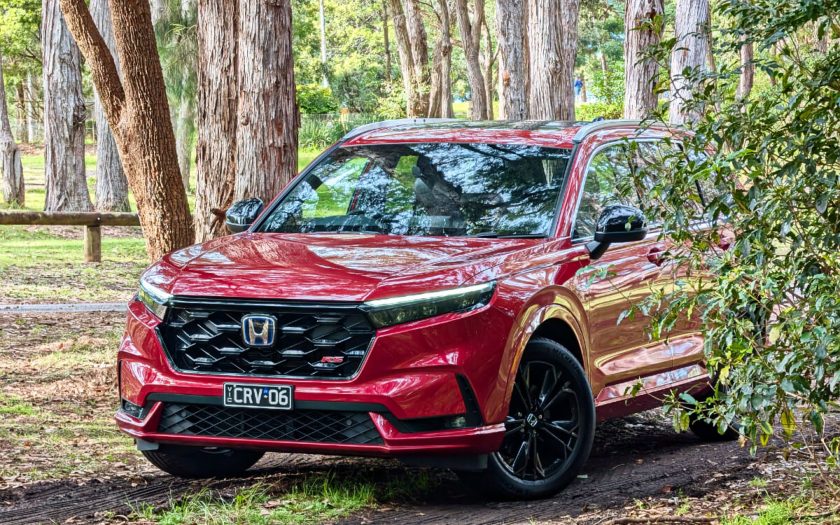Chris Riley tests the 2024 Honda CR-V e:HEV RS petrol-electric hybrid mid-size SUV with pricing, specs, ride and handling, safety, verdict and everything the over-50 driver needs to know.
Summary: Compared with other vehicles, the Honda CR-V e:HEV RS looks expensive, especially since it only comes in two-wheel drive.
2024 Honda CR-V e:HEV RS petrol-electric hybrid mid-size SUV
Pricing: $60,400 (plus on road costs)
Warranty: Five-years, unlimited km, five-year roadside assist five-years complimentary over-the-air map upgrades
Safety: not tested
Engine: 2.0-litre naturally aspirated inline four-cylinder petrol engine, plus two electric motors
Service intervals: 12 months or 10,000km, first five capped at $199
Power: 135kW, 152kW combined
Torque: 335Nm
Transmission: constantly variable, front-wheel drive
Body: 4704mm (long); 1866mm (wide); 1681mm (high)
Build country: Thailand
Kerb weight: 1771kg
Towing capacity: 1600kg
Luggage capacity: 581 litres, 1636 litres (seats folded)
Wheels: 19-inch alloy
Tyres: 235/55R19
Spare wheel: tyre repair kit
Ground clearance: 198mm
Turning circle: 11.0m
Fuel tank: 57 litres
Consumption: 5.5L/100km (91 RON)
Consumption on test: 6.3L/100km (740km)
seniordriveraus consumption on test: not tested
[review]
The Honda CR-V e:HEV isn’t the Japanese company’s first petrol-electric hybrid, it’s the latest in a long line of hybrids that started with the cutting-edge, two-seat Insight way back in 2001.
But the CR-V e:HEV (it’s a mouthful) has a big role to play as Honda fights to find a place in the new order of things that started with the move to SUVs, then the swing to electric vehicles and finally the arrival of the Chinese – in full force.
You might say it’s time to shape up or ship out.
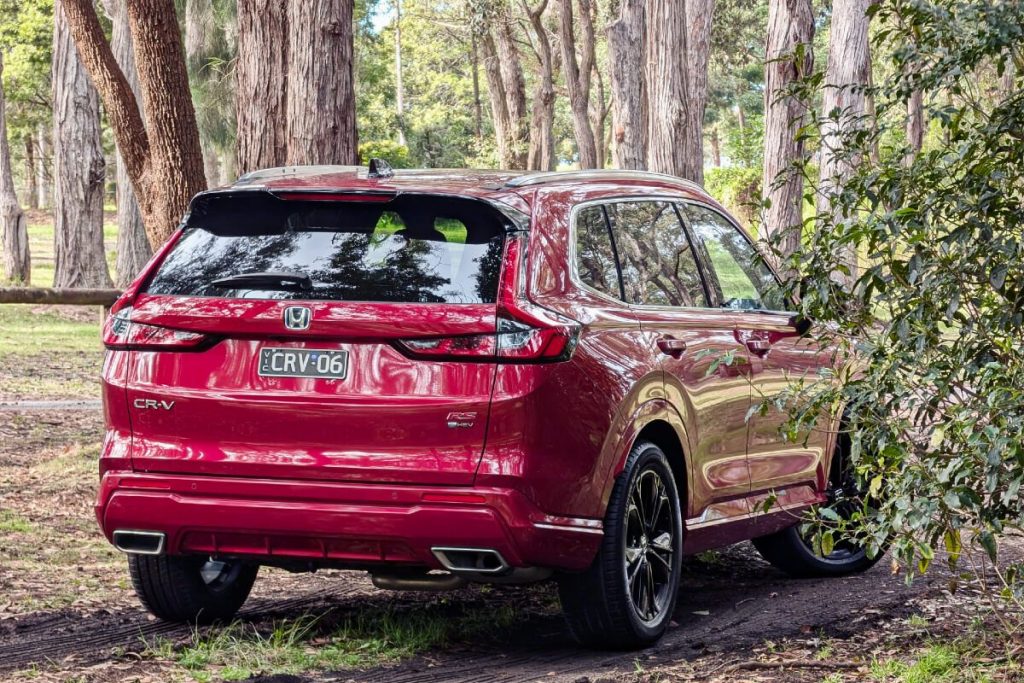
What’s it cost?
CR-V starts from $44,700 driveaway for the five-seat, two-wheel drive 1.5-litre VTi X+ with an auto.
The VTi X7 is basically the same model with seven seats and is priced from $46,800.
There are six colours and seven grades from which to choose: VTi X+, VTi X7, VTi L, VTi L7, VTI L AWD, VTi LX AWD and e:HEV RS.
All but the hybrid are powered by the same 1.5-litre four cylinder turbo.
Only VTI L and VTI LX are available with all-wheel drive (VTI L with all-wheel drive is $2500 more).
Standard kit is generous, with cloth trim and two-zone climate air, auto lights and wipers, an auto-dimming rear view mirror, keyless entry and start, electric parking brake, power adjust driver seat, walk-away door locking, front and rear parking sensors, reverse camera with dynamic guides plus a hands-free power tailgate.
The RS ups the ante with a sports body kit along with some sporty touches inside, including alloy pedals, black headliner, leather accents and red stitching for the seats, steering wheel and transmission shift.
It also comes with a sunroof, rear fog lights, adaptive high beam and active cornering lights – all of them LED.
Importantly, as you will soon discover, it’s also the only model that gets sport drive mode along with an enhanced engine note.
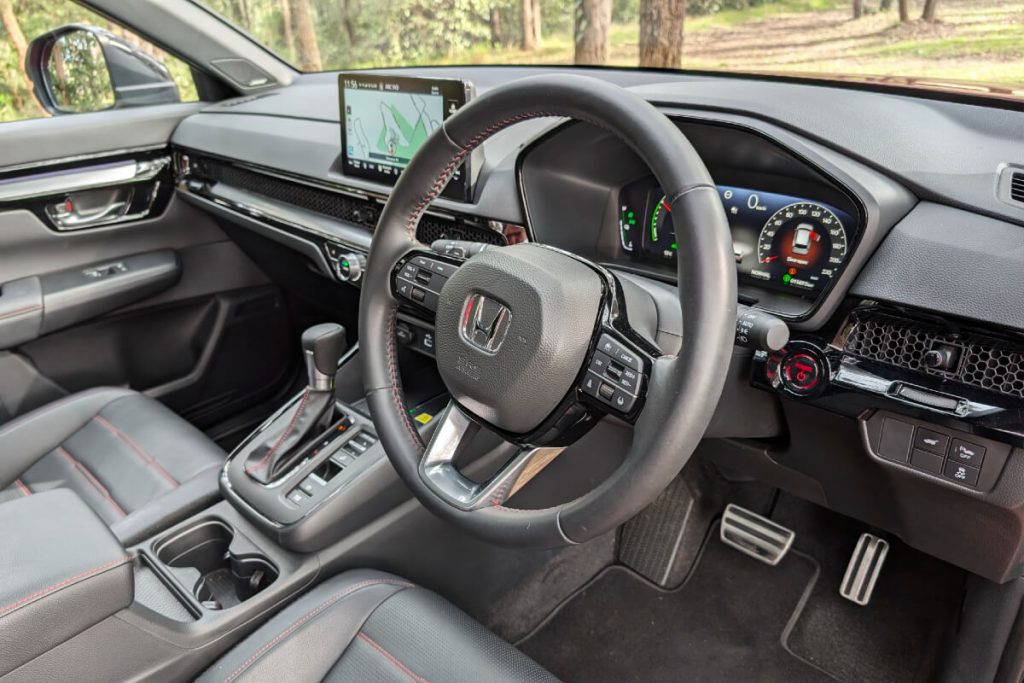
The Honda CR-V comes with a five-year unlimited kilometre warranty, plus five-year roadside assistance.
Service intervals are 12 months or 10,000km, with the first five visits capped at $199.
Variants with built-in navigation receive five years of complimentary over the air map updates.
Infotainment consists of a 9.0-inch colour touchscreen, eight-speaker audio, active noise control, Bluetooth, AM/FM/DAB+ digital radio, wireless Apple CarPlay and wired Android Auto, wireless smartphone charging pad plus connection to the Honda Connect app.
The VTi-L adds satellite navigation and a Smart KeyCard.
There’s USB-A and -C ports in front, along with a 12-volt/180W outlet, with another two USB-C ports in the back and a 12-volt outlet in the luggage area.
RS gets 12-speaker Bose audio.
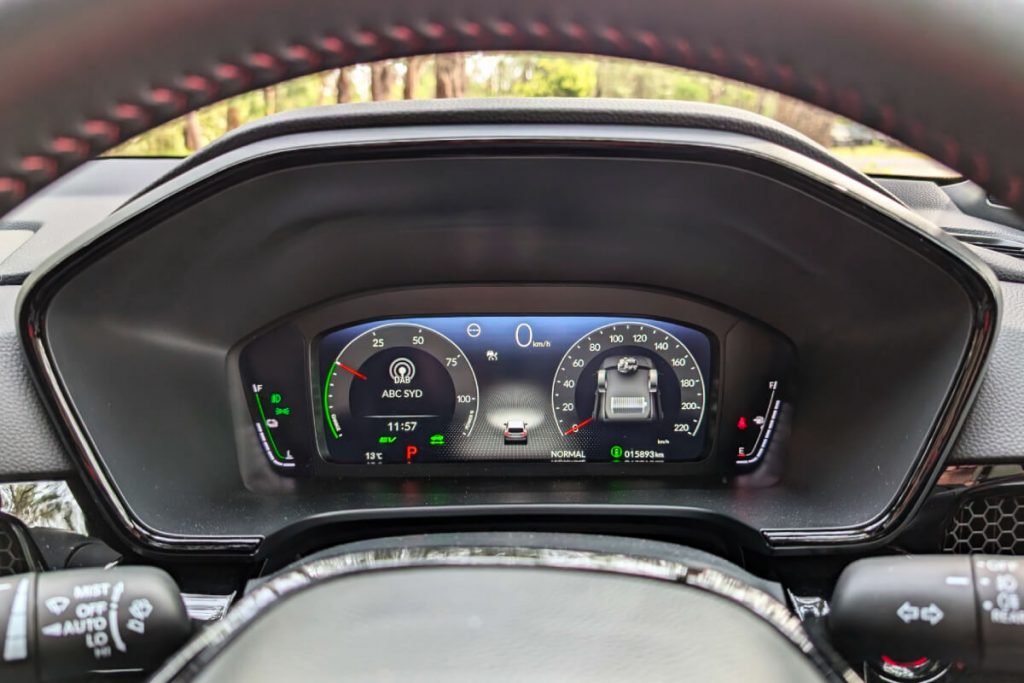
The new CR-V is still to be rated by ANCAP for safety.
An improved Honda Sensing safety system features a total of 11 airbags, with a new front camera and radar system.
Honda’s Advanced Compatibility Engineering (ACE) body structure has been updated to distribute crash energy more evenly throughout the front, side, and rear of the vehicle.
There’s also forward collision warning, autonomous emergency braking (AEB), lane departure and lane keep assist, traffic jam assist, road departure mitigation, adaptive cruise control, low-speed braking control, traffic sign recognition and high beam support.
VTi-L and above add blind spot monitoring and rear cross traffic alert with e:HEV RS also getting LED active cornering lights and adaptive driving beam.
However, there’s no head-up display or 360-degree camera.
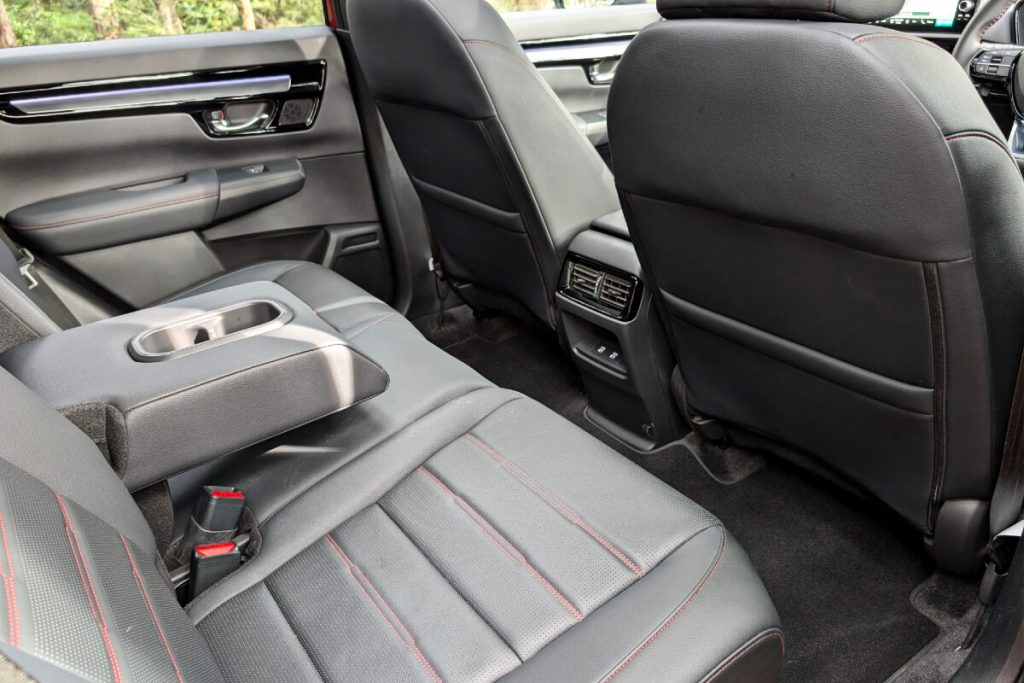
What’s it go like?
CR-V, as we recall, originally stood for Civic Recreational Vehicle, but this has now morphed into Comfortable Runabout Vehicle.
No matter because it is reasonably comfortable as well as roomy inside, and comes with a new-found upmarket feel.
With reach and height adjustment for the steering wheel and plenty of power adjustment options for the driver’s seat, finding the right driving position is easy.
The front seats are also heated.
With 15mm more legroom, the rear seats also slide 190mm backwards or forwards, in case you need even more room.
And they recline, with 16 positions and an additional 10.5 degrees – so passengers can kick back on longer trips.
Boot space is a generous 581 litres but the floor hides a tyre repair kit.
The objective was reportedly to achieve the ultimate all-rounder, encompassing the same off-road performance as a cross-country vehicle, the same level of comfort as a passenger car and even the same level of appeal for sports car lovers.
Dream on….
The hybrid combines two electric motors with a larger, 2.0-litre direct injection Atkinson style four-cylinder engine.
The electric motors are positioned side-by-side rather than in-line with the crankshaft as they were previously.
The all-new E-CVT motor spins at 14,500 rpm and produces 135kW peak power and 335Nm of torque.
The generator motor, which spins at 17,000 rpm, puts out 120kW and is dedicated to charging the battery pack.
Combined system output is 152kW.
The 1.5-litre turbo makes 140kW and 240Nm in comparison.

Three drive modes are available, selected via a console mounted switch: Economy, Normal and Sport in the RS.
The new set up also includes new high and low-speed lock-up ratios for direct engine drive on the highway and in the city.
A new “B” transmission setting enables stronger regenerative and engine braking.
This can also be controlled using the supplied steering wheel paddles.
On paper it all sounds fabulous and it is until you get the opportunity to stretch the CRV’s hybrid legs.
While it’s reasonably quick off the mark thanks to the instant kick from the electric motor, the CR-V quickly runs out of puff.
This becomes especially evident when it comes to overtaking and climbing long, steep hills where the hybrid powertrain starts to wail like a banshee as it attempts to deliver the goods.
At this point, the provision of Sport mode makes a real difference and is the only cure for its rural-induced asthma, but of course it must be selected each and every time you start the vehicle.
It brings the CR-V to life, ramping up the revs, enhancing throttle response and giving the vehicle a much sportier feel.
In comparison, performance in Economy mode is woeful and we gave it away within minutes.
Normal, as the name suggests, is fine for most situations.
In addition, with Sport mode activated Active Sound Control boosts the engine note.
Steering is light and the ride quality is generally pretty good, although cabin noise can be intrusive on coarse bitumen and the ride can become jarring.
The 12-speaker Bose sound system is excellent.
Too bad Android Auto requires a cable and is not wireless like CarPlay.
Rated at 5.5L/100km, we were getting 6.3L after 740km of mixed driving, much of it out west.
Fortunately, the 57-litre tank is happy to take standard 91 RON petrol.
What we like
- Looks schmick
- No haggle pricing
- Rear air outlets
- Rear USB charge ports
- Lots of rear legroom
- Good-sized boot for the fam
- Takes standard unleaded petrol
What we don’t like
- Expensive
- Two-wheel drive
- Lacks punch
- Engine noisy under load
- Tyre repair kit
- Lousy satnav system
- Hybrid confined to costly RS version
- Marginal gains in fuel consumption
- Up to 158kg heavier than petrol model
- Short 10,000km service intervals
- Doesn’t have a safety rating
What over-50s need to know
We just can’t see how Honda’s price it up policy has legs.
While the CR-V hybrid is a practical, polished offering, petrol-only versions represent better value for money.
What’s more, although CR-V is advertised as “Available in Hybrid with 5 and 7-seat options,” the hybrid is in fact available only in expensive, top of the line RS form and not with seven seats. It misses out on all-wheel drive as well.
But for older drivers, the price may not be a deterrent.
It’s an SUV and it is reasonably comfortable, well-equipped and doesn’t use much fuel.
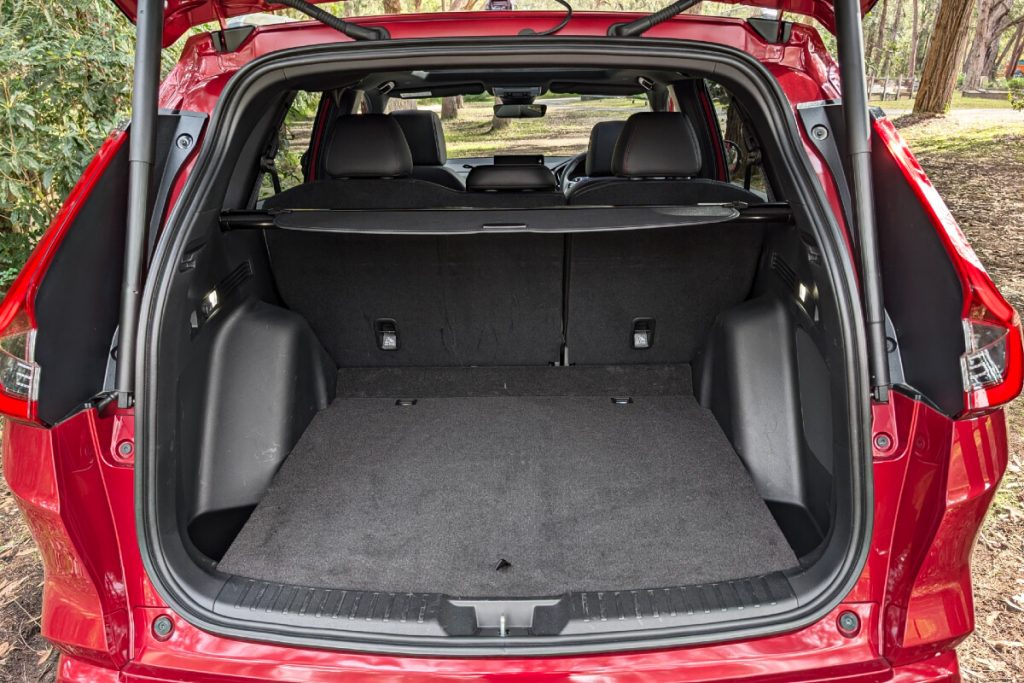
seniordriver comments
It’s hard to see where the CR-V’s customers will come from.
The lack of all-wheel drive in the e:HEV is hard to understand (although it would have pushed the price even higher).
All variants are well-equipped but the RS raises the bar a little higher, and is the only model that gets Sport mode.
Some buyers are going to be disappointed with the relatively short service intervals of 12 months, but at least the first five are capped at just $199.
The absence of an ANCAP rating is a cause for concern, although there is no reason to think that it wouldn’t score a full five points. The lack of heads-up display or 360-degree camera is hard to understand and may be an issue for some over-50s drivers.
